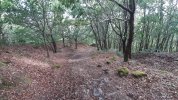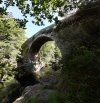- Time of past OR future Camino
- Many, various, and continuing.
"Waybread: Memories of the Camino for the Onward Journey" by Laurie Dennett. Peaceable Publishing, Moratinos Spain, 2023. 301 pages, paper and e-book.
Finally in English: a timely collection of speeches, studies and observations of the history of Camino de Santiago pilgrimage phenomenon, by Laurie Dennett, noted Canadian writer, historian and pilgrim.
>Bunk down on the floor of the dining room at Don Elias Valina’s pilgrim hospederia in O Cebreiro, circa 1989, and learn how one man’s vision fast-forwarded this mountain village from the Middle Ages to modernity in a single generation….
>March across the meseta with juvenile convicts from Belgium, walking off their sentences as part of the Oikoten rehab program…
>Meet the Basque priest who founded nine non-profit pilgrim shelters in the early 1990s... Sail aboard a 15th century English pilgrimage ship from Bristol, Plymouth, or Portsmouth – and walk the English Way from A Coruna…
> See how the pilgrim credential evolved from an early Safe Conduct document, what the first Compostela certificate signified, and how “pilgrims” have for years bent the rules. Learn the real story behind the yellow arrows that first marked the latter-day Camino path.
“Waybread” is a book full of fascinating detail, photos, and fun anecdotes, all centered on the ever-growing Camino de Santiago pilgrimage trail. Check out the details at www.waybread.org.
Dennett was president of the Confraternity of St. James in UK for eight years, and was one of the first English-speaking pilgrims to set down her experiences – her “A Hug for The Apostle” (1986) became a Camino classic. Lovers of the pilgrimage Way will enjoy these historical artifacts – observations of an ever-changing path as seen through loving but critical eyes.
Brought to you by Peaceable Publishing
Finally in English: a timely collection of speeches, studies and observations of the history of Camino de Santiago pilgrimage phenomenon, by Laurie Dennett, noted Canadian writer, historian and pilgrim.
>Bunk down on the floor of the dining room at Don Elias Valina’s pilgrim hospederia in O Cebreiro, circa 1989, and learn how one man’s vision fast-forwarded this mountain village from the Middle Ages to modernity in a single generation….
>March across the meseta with juvenile convicts from Belgium, walking off their sentences as part of the Oikoten rehab program…
>Meet the Basque priest who founded nine non-profit pilgrim shelters in the early 1990s... Sail aboard a 15th century English pilgrimage ship from Bristol, Plymouth, or Portsmouth – and walk the English Way from A Coruna…
> See how the pilgrim credential evolved from an early Safe Conduct document, what the first Compostela certificate signified, and how “pilgrims” have for years bent the rules. Learn the real story behind the yellow arrows that first marked the latter-day Camino path.
“Waybread” is a book full of fascinating detail, photos, and fun anecdotes, all centered on the ever-growing Camino de Santiago pilgrimage trail. Check out the details at www.waybread.org.
Dennett was president of the Confraternity of St. James in UK for eight years, and was one of the first English-speaking pilgrims to set down her experiences – her “A Hug for The Apostle” (1986) became a Camino classic. Lovers of the pilgrimage Way will enjoy these historical artifacts – observations of an ever-changing path as seen through loving but critical eyes.
Brought to you by Peaceable Publishing


























